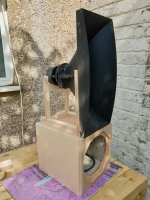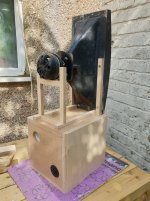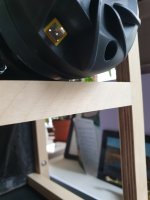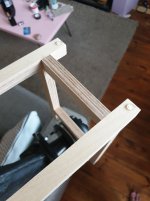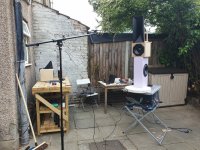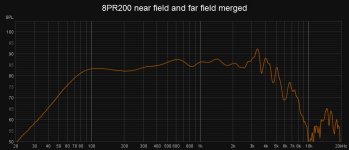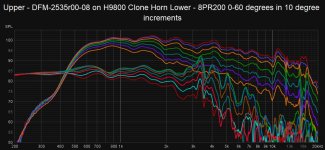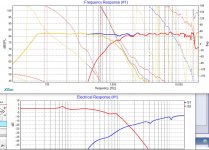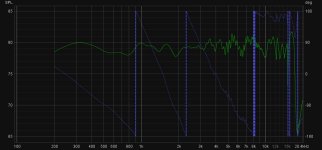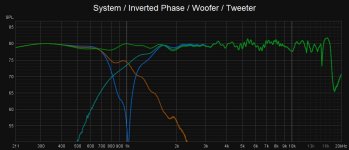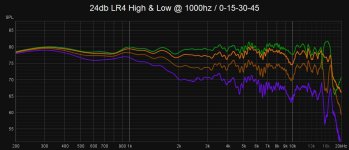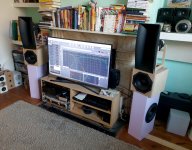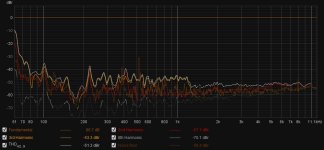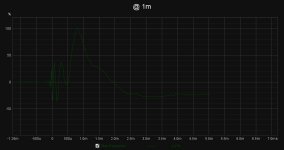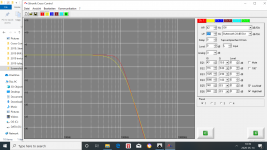Graham, due to the path you're following for this custom build, here's yet another thread to read for a bit more inspiration ( re ; the benefits from the vertical horn thing ).
JBL Studio 590's
🙂
JBL Studio 590's
An externally hosted image should be here but it was not working when we last tested it.
🙂
Quick answer: driver "break in" is mostly a myth.
If a particular driver is way out of spec, it just needs to be replaced 🙂
Marco
In the context this doesn't compute. New driver, yet out of spec.
Break in (pretty severe I might add) is used each and every time a transducer is measured to produce it's final datasheet by the factory.
That the driver could have to be replaced because it's out of spec is of course right, but doesn't explain the new Faital Pro driver from being out of spec.
Maybe it does need some break in, there's no way to be sure unless you contact faital pro and ask them what's going on.
How about a rubber tile to seperate it from the box below.
Same for the driver and I would make the wood as long as the horn and use braces to stiffen it up.
Same for the driver and I would make the wood as long as the horn and use braces to stiffen it up.
Graham, due to the path you're following for this custom build, here's yet another thread to read for a bit more inspiration ( re ; the benefits from the vertical horn thing ).
JBL Studio 590's
An externally hosted image should be here but it was not working when we last tested it.
🙂
Cheers, Earl. I had a good read, the tilting/towing correlates with my thoughts on my measurement regime that I am yet to decide on.
Since the vertical centre of the horn will be (for the time being) about 6" higher than my ears I am thinking about tilting the horn down. In turn this makes me think of where the mic should be for the measurement process.
A: On axis/vertical centre of horn (no tilt)
B: Ear height lower down the vertical line (no tilt)
C: Ear height angled towards tilted horn
The rotated horizontal (now vertical) diffraction characteristics of the H9800 will govern this I suppose being DSP I have a lot of flexibility. Testing vertical off axis response will be tricky.
How about a rubber tile to seperate it from the box below.
Same for the driver and I would make the wood as long as the horn and use braces to stiffen it up.
I'm one step ahead of you! I used little rubber "bumpons" that are sufficiently squished to give some stability and maybe isolation. I'll look in to sorbothane if I get pedantic. I also used these little "bumpons" to keep the compression driver supported.
Yes, I could have run the frame up the whole length of the horn but it is made from birch ply and fibreglass so I am confident it is sturdy. Again, I can always reassess.
Attachments
How far away are you going to be?? Easy enough to do. My center channel is tilted down a couple of degrees.
Rob🙂
Rob🙂
How far away are you going to be?? Easy enough to do. My center channel is tilted down a couple of degrees.
Rob🙂
Well, listening position is about 2 metres or just under. I did some measuring today with the horn tilted down outside but various uncrontroable noise factors meant the measurements were all over the place. My front room is only 2.4m high x 3.5m x 4m. I'm concerned that with the height of the stack I won't be able to get far away enough from it without room interaction.
I was reading another thread here last night and I am glad I did, the outside measurements gave vastly differing phase graphs from repeated sweeps.
Right, so as mentioned I kind of consider the outside measurement escapade a bit of a write off due to phase measurements being all over the place between like measurement to like measurement. Bit of a shame but now I know.
The frequency responses give me a good idea of what they should look like, though and what I should be looking for when I retry them in doors.
I am pretty confident that directivity looks fairly well match for a crossover anywhere between 800-1500hz. Measurements done at 105cm.

...and the midbass response looks OK although, far field and nearfield merging always feels like a big fat gamble to me despite how many guides on it I read:

It's a real struggle doing anything with a good degree of what I think is accurate in a small flat in London. I couldn't get up to 2.83v for testing as I was worried my neighbours might think the sine sweep was some sort of evacuation signal - it would have been heard for at least a mile.
Here is the set up, not perfect and I know the ledge of my lazy susan was protruding (I covered it in a wool blanket for actual measurements. The mic and stack were both at least 1.6m away from any surface.
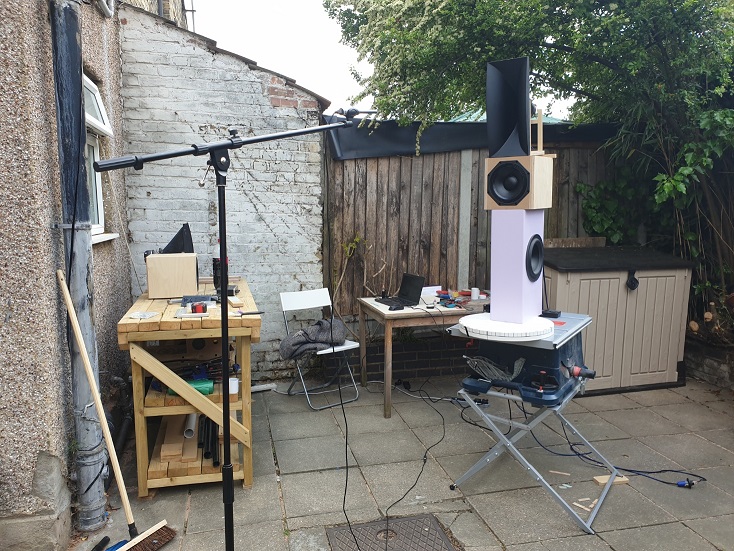
Here is a quick XO I knocked up but I don't trust it. I suppose I could just measure it inside and adjust delays until the null shows true.
LR4 High / Low Pass @ 1khz - 0.241 milliseconds delay.

The frequency responses give me a good idea of what they should look like, though and what I should be looking for when I retry them in doors.
I am pretty confident that directivity looks fairly well match for a crossover anywhere between 800-1500hz. Measurements done at 105cm.
...and the midbass response looks OK although, far field and nearfield merging always feels like a big fat gamble to me despite how many guides on it I read:
It's a real struggle doing anything with a good degree of what I think is accurate in a small flat in London. I couldn't get up to 2.83v for testing as I was worried my neighbours might think the sine sweep was some sort of evacuation signal - it would have been heard for at least a mile.
Here is the set up, not perfect and I know the ledge of my lazy susan was protruding (I covered it in a wool blanket for actual measurements. The mic and stack were both at least 1.6m away from any surface.
Here is a quick XO I knocked up but I don't trust it. I suppose I could just measure it inside and adjust delays until the null shows true.
LR4 High / Low Pass @ 1khz - 0.241 milliseconds delay.
Attachments
Last edited:
Hi all!
I have a very frustrating day doing this in a rush when my wife was out for an hour or so. I ended up taking two hours and I am not happy with it. I mean, it sounds nice but not right.

I couldn't get Z offset right to make simulations even though I took new measurements inside. It was very frustrating. I ended up doing a manual process in REW. I EQ'd, swept/measured then repeated. The same for delay.
This is what I came up with, no idea what happened between 500hz-1khz with that dip:




My first impressions are that that it sounds very spacious and huge which is what I wanted. It does have a limited sweet spot, though. I didn't anticipate it having this narrow and spot, not sure how to address that. The Peerless CDs are very very nice indeed. From my limited experience there is something that horn/CD combos bring to brushed snares and these do it. Very nice and like you are there, you know?
I have a very frustrating day doing this in a rush when my wife was out for an hour or so. I ended up taking two hours and I am not happy with it. I mean, it sounds nice but not right.
I couldn't get Z offset right to make simulations even though I took new measurements inside. It was very frustrating. I ended up doing a manual process in REW. I EQ'd, swept/measured then repeated. The same for delay.
This is what I came up with, no idea what happened between 500hz-1khz with that dip:
My first impressions are that that it sounds very spacious and huge which is what I wanted. It does have a limited sweet spot, though. I didn't anticipate it having this narrow and spot, not sure how to address that. The Peerless CDs are very very nice indeed. From my limited experience there is something that horn/CD combos bring to brushed snares and these do it. Very nice and like you are there, you know?
Attachments
I forgot to check and to post the step response. Looks like the woofer is late by 0.5ms however, I had t delay the woofer by 0.4ms to get the crossover to work well. I wonder if that is the source of my irk.
Let me know if there is any other pertinent data needed for analysis 🙂

Let me know if there is any other pertinent data needed for analysis 🙂
Attachments
Try with a 18db Butterworth filter and maybe offset it to 8-900Hz, it should create a small peak just under 1kHz.
I use this trick with my horn but increasing lower range instead. Ideally you should straighten the peak of the mid woofer at 1kHz also, then lower the horn with a few db.
Don't know if it works but maybe worth to try...
I use this trick with my horn but increasing lower range instead. Ideally you should straighten the peak of the mid woofer at 1kHz also, then lower the horn with a few db.
Don't know if it works but maybe worth to try...
Hey Graham,
You might try adding some temporary ( vertically oriented at least ) cardboard horn wings ( to mimic the small flares seen in the Studio 590's ).
They should add a bit of extra directivity to your 8" mid-woof ( which in turn should help better blend it's polars with those from the vertical horn above).
- They might also help mitigate some measurable diffraction effects (from pulling down the 8 inchers top octave of FR ) .
- I'd be shooting for some enhanced directivity going from 700hz up to 10K if you can manage it.
I figure G.T. knew what he was doing when he recessed all the mid-woofs ( plus added little waveguides ) in that series ( & not just for better phase alignment purposes at crossover ).

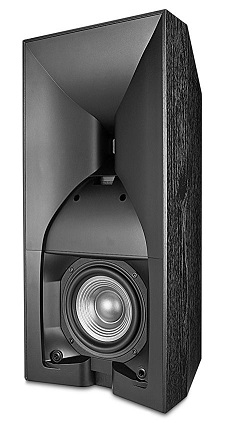
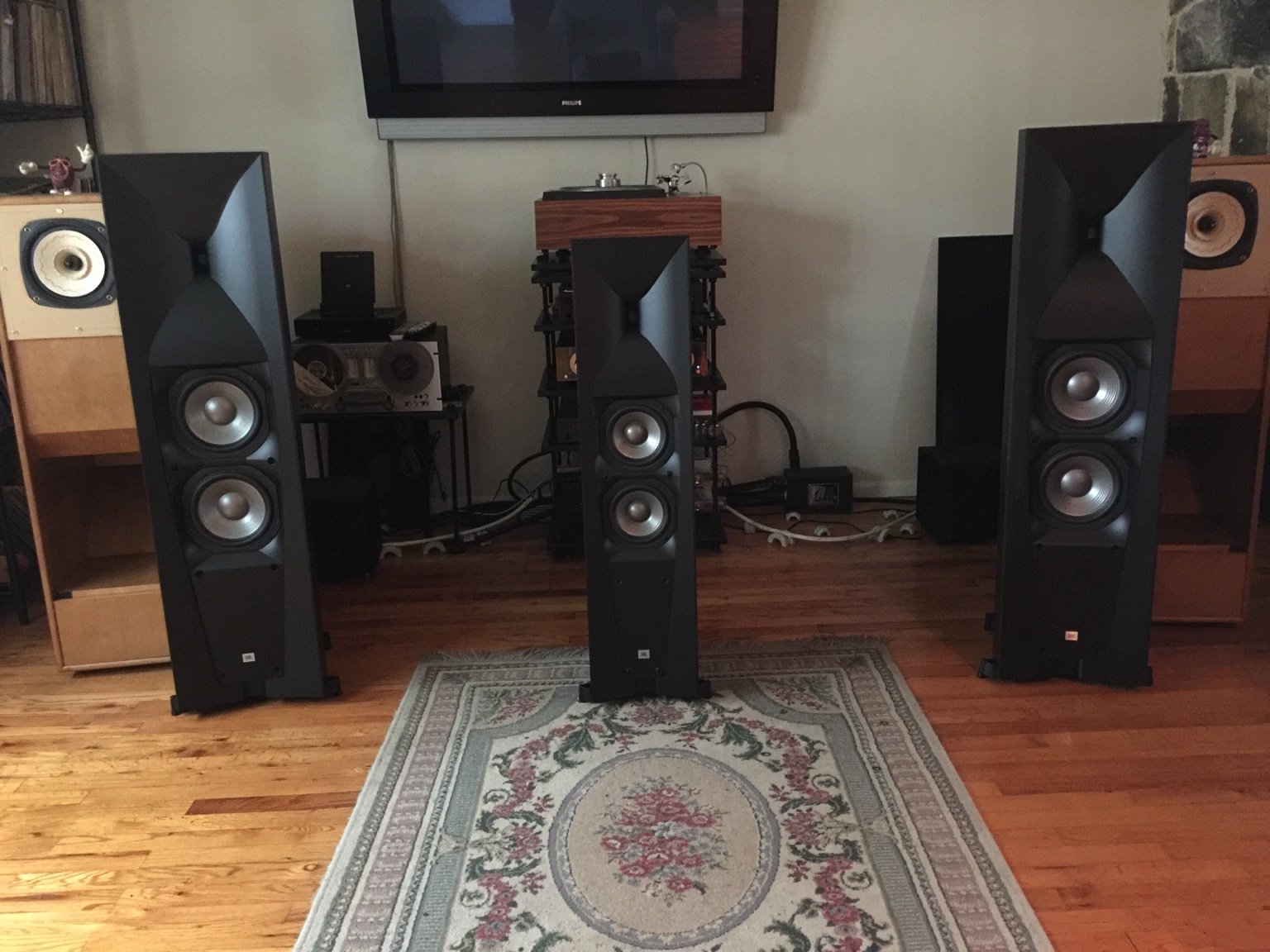
🙂
PS; If you reread the Studio 590 review ( that I posted earlier ) you'll see that Michael ( tomlinmgt ) ended up orienting his 590's pointing straight forwards ( in his well treated room ).
- Depending on your listening location that should bring into play ( to one or both of your ears ) the 6db drop-off seen in that horns polar pattern .
- Engaging ( experiencing ) that 6 db step-down is critical ( IMHO + IME ) to achieving depth-of-field ( when trying to trick one's ears into "thinking" there's depth in a recording ).
- You might need to treat your side walls somewhat to attenuate first reflection points to keep that 6db drop properly delineated ( iow; the polars tracking > without bunching or crossing at your listening position).
🙂
You might try adding some temporary ( vertically oriented at least ) cardboard horn wings ( to mimic the small flares seen in the Studio 590's ).
They should add a bit of extra directivity to your 8" mid-woof ( which in turn should help better blend it's polars with those from the vertical horn above).
- They might also help mitigate some measurable diffraction effects (from pulling down the 8 inchers top octave of FR ) .
- I'd be shooting for some enhanced directivity going from 700hz up to 10K if you can manage it.
I figure G.T. knew what he was doing when he recessed all the mid-woofs ( plus added little waveguides ) in that series ( & not just for better phase alignment purposes at crossover ).

🙂
PS; If you reread the Studio 590 review ( that I posted earlier ) you'll see that Michael ( tomlinmgt ) ended up orienting his 590's pointing straight forwards ( in his well treated room ).
- Depending on your listening location that should bring into play ( to one or both of your ears ) the 6db drop-off seen in that horns polar pattern .
- Engaging ( experiencing ) that 6 db step-down is critical ( IMHO + IME ) to achieving depth-of-field ( when trying to trick one's ears into "thinking" there's depth in a recording ).
- You might need to treat your side walls somewhat to attenuate first reflection points to keep that 6db drop properly delineated ( iow; the polars tracking > without bunching or crossing at your listening position).
Good advice and I indeed do have a little tilt back going on there with mine. I found it to smooth out the slight sibilance issue I struggled with for the first several months that I owned them. And no toe in...I like ‘em firing straight ahead. Off axis, in both horizontal and vertical planes, is the name of the game with the 590’s.
I don’t think I have mine raised 1/2” in front, though...maybe a little less than that. I’ll try more and see what happens.
🙂
Last edited:
Round 2.
Morning all!
I took on board your commentsbut tghere was something that was ultimatey too distracting with the H9800 horns to keep them permenantly. Quite simply it was the varying response at different locations I think due a couple of things - massive centre to centre distance of horn and mid woofer (I could very easily locate ride cymbals combing from the horn rather than the speaker system) and the issues at 16k caused by some sort of diffraction due to mismatching exit angle or diffraction slot tom-foolery.
So, I moved on to trying the STH100 horns which I mounted in a very simple template cut birch ply plate that once the horn was screwed to really look any physic ring in the aluminium. Not that I noticed any honk before or in the spectogram before.
Measurements at 1m indoors. Horn tilted up 8 degrees. For anyone wondering the flat response is not final, it just for showing the system before I added a downward tilt high shelf filter (-1.5db / Q 0.5 / 2000hz) to adjust for brightness to taste.
LR4 @ 1500hz / 0.06ms delay on midwoofer.
Polar Response:

Components:

Phase and Distortion:


It is a very different sound and I can't quite put my finger on it apart from a few things.
1. Massively more cohesive. Moving my head around or being in different locations at on the sofa gives a far more pleasant variation in response.
2. It doesn't sounds as big. Perhaps, quite simply, because the radiating area of the horn is much smaller than the H9800?
3. Visual impact is so different it's hard not to ignore.
I am still a bit concerned about the funny looking regions just before and after crossover that don't look like they sum correctly being slightly proud of the system response.
I woudl still like to tackle having a bit more directivity under 1khz.
Cheers all! 🙂
Morning all!
I took on board your commentsbut tghere was something that was ultimatey too distracting with the H9800 horns to keep them permenantly. Quite simply it was the varying response at different locations I think due a couple of things - massive centre to centre distance of horn and mid woofer (I could very easily locate ride cymbals combing from the horn rather than the speaker system) and the issues at 16k caused by some sort of diffraction due to mismatching exit angle or diffraction slot tom-foolery.
So, I moved on to trying the STH100 horns which I mounted in a very simple template cut birch ply plate that once the horn was screwed to really look any physic ring in the aluminium. Not that I noticed any honk before or in the spectogram before.
Measurements at 1m indoors. Horn tilted up 8 degrees. For anyone wondering the flat response is not final, it just for showing the system before I added a downward tilt high shelf filter (-1.5db / Q 0.5 / 2000hz) to adjust for brightness to taste.
LR4 @ 1500hz / 0.06ms delay on midwoofer.
Polar Response:
Components:
Phase and Distortion:
It is a very different sound and I can't quite put my finger on it apart from a few things.
1. Massively more cohesive. Moving my head around or being in different locations at on the sofa gives a far more pleasant variation in response.
2. It doesn't sounds as big. Perhaps, quite simply, because the radiating area of the horn is much smaller than the H9800?
3. Visual impact is so different it's hard not to ignore.
I am still a bit concerned about the funny looking regions just before and after crossover that don't look like they sum correctly being slightly proud of the system response.
I woudl still like to tackle having a bit more directivity under 1khz.
Cheers all! 🙂
Attachments
-
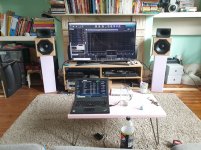 20200608_081222.jpg223.8 KB · Views: 131
20200608_081222.jpg223.8 KB · Views: 131 -
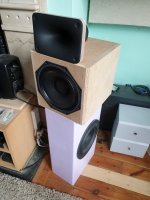 20200608_081156.jpg182.8 KB · Views: 133
20200608_081156.jpg182.8 KB · Views: 133 -
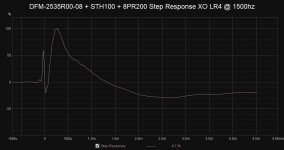 DFM-2535R00-08 + STH100 + 8PR200 Step Response XO LR4 @ 1500hz.jpg88.2 KB · Views: 426
DFM-2535R00-08 + STH100 + 8PR200 Step Response XO LR4 @ 1500hz.jpg88.2 KB · Views: 426 -
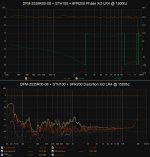 DFM-2535R00-08 + STH100 + 8PR200 Phase and Distortion XO LR4 @ 1500hz.jpg266.2 KB · Views: 413
DFM-2535R00-08 + STH100 + 8PR200 Phase and Distortion XO LR4 @ 1500hz.jpg266.2 KB · Views: 413 -
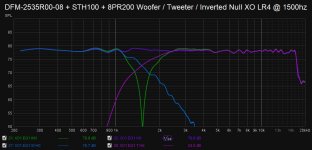 DFM-2535R00-08 + STH100 + 8PR200 Woofer - Tweeter - Inverted Null XO LR4 @ 1500hz.jpg139.7 KB · Views: 406
DFM-2535R00-08 + STH100 + 8PR200 Woofer - Tweeter - Inverted Null XO LR4 @ 1500hz.jpg139.7 KB · Views: 406 -
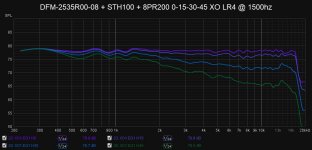 DFM-2535R00-08 + STH100 + 8PR200 0-15-30-45 XO LR4 @ 1500hz.jpg137.7 KB · Views: 407
DFM-2535R00-08 + STH100 + 8PR200 0-15-30-45 XO LR4 @ 1500hz.jpg137.7 KB · Views: 407 -
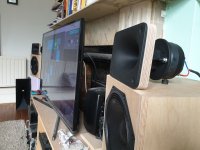 20200608_081312.jpg182.4 KB · Views: 149
20200608_081312.jpg182.4 KB · Views: 149
Did you add any delay to the woofer path ?
Regards
Charles
Yes, 0.06ms.
- Home
- Loudspeakers
- Multi-Way
- System Based Around JBL H9800 Horn
